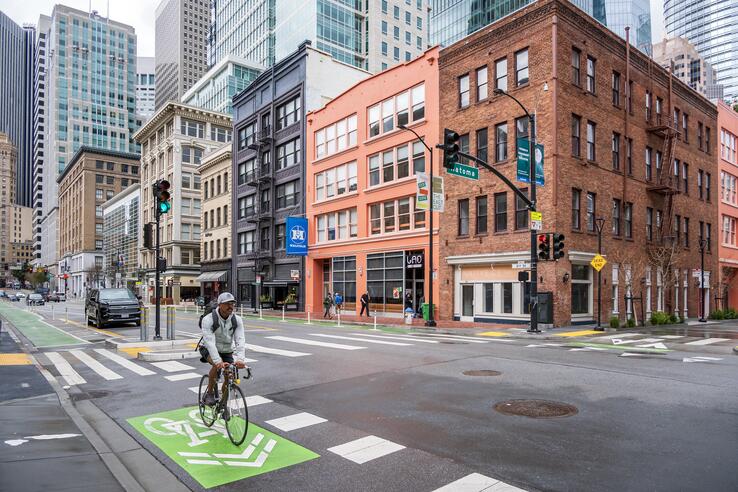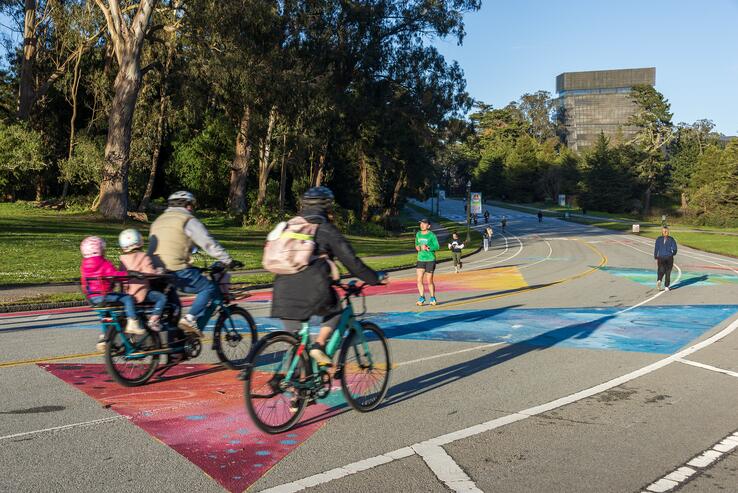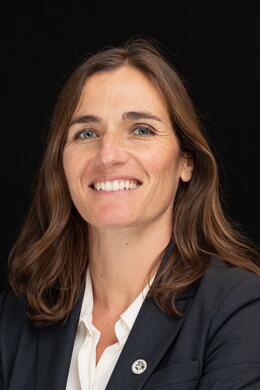April marked the 10-year anniversary of Vision Zero, an effort to eliminate traffic-related deaths and severe injuries on San Francisco roads. Despite some impressive progress by the San Francisco Municipal Transportation
We sat down with SFMTA Board Chair Amanda Eaken to discuss effective advocacy and San Francisco’s transportation future. We started our conversation by asking Amanda about her own experience of San Francisco’s streets and what she envisions for their future.
What motivated you to join and lead the SFMTA Board?
For most of my career, I’ve worked at environmental organizations focused on creating sustainable transportation choices like walking, biking, and public transportation. I’ve led campaigns to change state policy in Sacramento, pushed for more climate-friendly federal transportation spending, and, most recently, supported 25 cities through the Bloomberg American Cities Climate Challenge to create low-carbon mobility options as a way to reach the Paris Agreement climate targets locally.
I grew up riding the M79 crosstown bus to school in New York City. My dad and I biked to West Side Soccer League practice in Riverside Park. When I got the call from the Mayor’s Office to join the SFMTA Board and help oversee San Francisco’s transportation system, it was a no-brainer. I also loved that for the first time in my life, being a bus rider was considered a special qualification for the job.
How do you and your family get around in San Francisco? How has that changed during your time living in San Francisco?
Surprising no one, I admit to being proud that our kids are quite Muni savvy. My daughters get to school at Lowell from NOPA by taking either the 24 Divisadero to the M Metro line or the 5 Fulton to the 28 19th Ave. Every morning you can hear them debating which route seems faster, as they check the transit app while brushing their teeth. It gives me so much joy that the kids can travel independently and confidently anywhere in the city. We are one of the roughly one-third of San Francisco households that don’t own a car, so our default is to find the best Muni route for whatever trip we need to take. Over the last year, my husband and I both bought Aventon e-bikes, which have opened up a lot of hilly routes we would have shied away from before. Ten years ago, I had a car. But my impatience with looking for parking and the ubiquity of carsharing systems like Zipcar and Getaround led us to sell it.

What changes to San Francisco streets would you like to see, and why?
I would love for us to commit to building out Mayor Breed’s vision for a citywide biking and rolling network that is safe and comfortable for all ages and abilities in the next five years. I just read that Paris has committed to becoming a 100% bicycle-friendly city in five years, and I think it’s a great goal. In transportation, we tend to have these outrageously long-term plans. As we all saw during the pandemic, the world can change so fast; five years seems like the right horizon to me. Right now about 3% of trips in San Francisco are by bike.
I worry a lot about the fact that we have a $225 million budget shortfall in Fiscal Year 2026–27. We will all work as hard as we can to close that gap, but we also have to reckon with the fact that significant cuts in transit service are possible. Should we face that devastating outcome, I feel it is our responsibility to make sure people have other affordable, convenient, fast ways to get around the city. I also love the transit team’s vision that the only reason the bus should stop in San Francisco is because it’s at a bus stop. This means we continue to build out Muni Forward projects that give dedicated street space to transit vehicles, to get our buses and trains out of traffic.
When it comes to Vision Zero, I see street safety as a fundamental right that everyone should expect from their government. It’s as basic as turning on the tap and expecting that the water is safe for you to drink. But it’s also important to me that safety is the floor; it’s the minimum. In my vision, our streets are so much more than just safe — they are places that support communities coming together and getting to know each other. Streets can be blank canvases for local artists, places where people can experience joy, delight, and dignity as they commute to work or cross the street.
In your experience, what is needed for effective streets advocacy? What tips do you have for advocates who are invested in street safety outcomes?
Two themes I’m very focused on right now are building trust in government and sharing information. I listen to a LOT of people testify at SFMTA Board meetings and share their views with me during my office hours. So often, community members are not working with all of the information that is available to me as a board member, so they jump to the wrong conclusions. I’m trying very hard in my role to share more information with members of the public so they can better direct their energy at the real challenges — often a lack of financial resources or a lack of political will or community support. Sometimes state or federal laws or practices get in the way.
One example I see as a shining success was the collaboration to pass AB 645, the Speed Safety Camera legislation, in 2023. For many years at the SFMTA, when we would discuss Vision Zero, our director, Jeff Tumlin, would say that the single-most effective tool we need is automated speed enforcement but that California law prohibited it. Walk SF and other advocates really took that guidance to heart, and the SFMTA collaborated with advocates for years to finally get authorization for this powerful tool last year. The cameras are set to be installed in early 2025. Without the hard work by Walk SF, Families for Safe Streets, and other advocates, I’m not sure this law would have passed.

In April 2020, San Francisco closed JFK Drive to cars, a move made permanent by a November 2022 ballot measure. The city also has the Slow Streets program and the car-free times on the Great Highway. How do you view the overlap between transportation infrastructure and public outdoor spaces where people play, eat, walk, and spend time with their families and neighbors?
What’s so magical about places like JFK Promenade is that there’s something for everyone there. It can be used as a safe and completely stress-free bicycle route, sure. But it’s also an outdoor art gallery. You can sit in the yellow chairs and visit with friends. You can embarrass yourself at the community sing-along around the western piano on Sundays. Or you can just take a stroll and enjoy the sounds and smells of the park. I would love to see us learn from the success of JFK and create a citywide network of car-free spaces that can support walking, biking, and rolling as transportation but also bring some of the joy, play, and community connection opportunities that JFK offers to neighborhoods across the whole city. In my mind, the 19 Slow Streets the SFMTA Board has already adopted are a perfect place to start.
What are the top three priorities for the SFMTA Board for the next 12 months?
If I may, we have six for the year 2024! They are summarized in a blog post I co-authored with Vice Chair Stephanie Cajina. They are transit, street safety, personal security, innovation and efficiency, communications, and budget.
How can advocates and organized coalitions better work to advance the goals of Vision Zero and street safety in San Francisco?
I am grateful to live in a city with so many people who care deeply about the place they live, believe that positive change is possible and necessary, and are willing to educate themselves about the possible pathways to make that change. I’ve worked with dozens of other cities across the country, and San Francisco has one of the most civically engaged populations I’ve seen.
I’d offer a few pieces of advice. First, seek to understand the root causes of the challenges that are creating the problem you are trying to solve. Ask a lot of questions, and learn the challenges that staff face. You’ll find that sometimes the root causes of the problems are issues that are out of the agency’s control.
Second, once those root challenges are surfaced, work hard to overcome them. For example, the Livable Streets team is working with a very small capital budget to deploy street safety improvements, and the mayor has put nearly $70 million for Vision Zero in her proposed 2024 General Obligation Bond. So advocates can work to solve a root cause problem by helping to get that bond passed.
Third, remember that the SFMTA staff are your neighbors, they are your fellow San Franciscans, they are hard-working, dedicated members of this community who deserve your respect. Of course it is your right to voice your opinion, but I guarantee you that berating staff is not going to get you what you want more quickly. I ask people to be their best selves and treat the staff the way they would want to be treated if the roles were reversed.
Fourth, please feel welcome to join my office hours so we can have a conversation. It’s great to come to SFMTA Board meetings at City Hall and testify, but the board is not permitted to engage in a Q&A, and I can imagine that’s frustrating for people. My office hours are virtual, at 4 p.m. the first and third Mondays of the month, the same weeks we have SFMTA Board meetings on Tuesdays.
SPUR works to reimagine safe streets that are welcoming to everyone. Our transportation team pursues state and local legislation, advocates for systems change, and organizes support for individual street redesigns in San Francisco.
